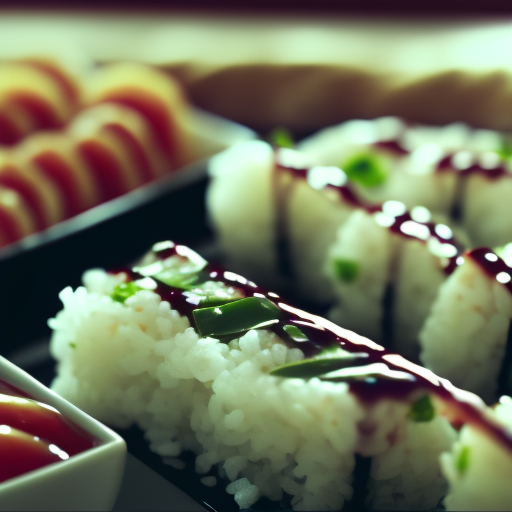
Rolling Waves: A Sushi Symphony
Introduction
Sushi, a traditional Japanese delicacy, has taken the world by storm. With its exquisite flavors and artistic presentation, sushi has become a global sensation. One of the most fascinating aspects of sushi is the way it is rolled, creating beautiful waves that resemble a symphony of flavors. In this article, we will explore the art of rolling sushi and how it contributes to the overall experience.
The Art of Sushi Rolling
A Delicate Balance
Rolling sushi requires a delicate balance of precision and creativity. The process involves combining fresh ingredients, such as fish, vegetables, and rice, and rolling them tightly in a sheet of seaweed called nori. This requires skill and practice to ensure the perfect balance of flavors and textures.
The Sushi Mat
To achieve the desired shape and tightness, sushi chefs use a bamboo mat called a makisu. The makisu acts as a guide and helps maintain the shape of the roll while ensuring it is rolled tightly. It takes years of practice for sushi chefs to master the art of rolling sushi using the makisu.
The Symphony of Flavors
The rolling technique used in sushi plays a significant role in enhancing the overall flavor profile. By carefully layering ingredients and rolling them tightly, the flavors meld together, creating a harmonious symphony on the palate. Each bite offers a burst of flavors that dance together in perfect harmony.
Types of Sushi Rolls
Maki
Maki rolls are the most common type of sushi roll. They consist of a layer of rice and various fillings wrapped in nori and then sliced into bite-sized pieces. Maki rolls come in different varieties, such as the classic California roll, spicy tuna roll, and vegetable roll.
Nigiri
Nigiri sushi is a type of sushi where a small mound of rice is topped with a slice of raw or cooked fish. The chef carefully forms the rice by hand and then delicately places the fish on top. Nigiri sushi showcases the simplicity and natural flavors of the ingredients.
Temaki
Temaki, also known as hand rolls, are cone-shaped sushi rolls. They are made by wrapping a sheet of nori around a mixture of rice and fillings. Temaki rolls are often enjoyed as a casual and interactive dining experience, allowing diners to assemble their own rolls at the table.
The Aesthetics of Sushi Rolling
Visual Appeal
The art of rolling sushi goes beyond taste; it also focuses on visual appeal. Sushi chefs take great care in creating visually stunning rolls that are pleasing to the eye. The vibrant colors of fresh fish, colorful vegetables, and contrasting textures make sushi an edible work of art.
Presentation
Sushi chefs pay attention to every detail when presenting their creations. From the arrangement of the rolls on the plate to the garnishes and sauces, presentation is key. The way sushi is rolled and presented adds to the overall dining experience, making it a feast for both the eyes and the taste buds.
Conclusion
Rolling sushi is an art form that combines precision, creativity, and a deep understanding of flavors. The beautiful waves created by the rolling process add to the symphony of flavors that sushi offers. Whether it’s a classic maki roll or an intricate nigiri, each bite of sushi is a sensory experience that delights both the palate and the eyes. So next time you indulge in sushi, take a moment to appreciate the artistry behind those rolling waves.